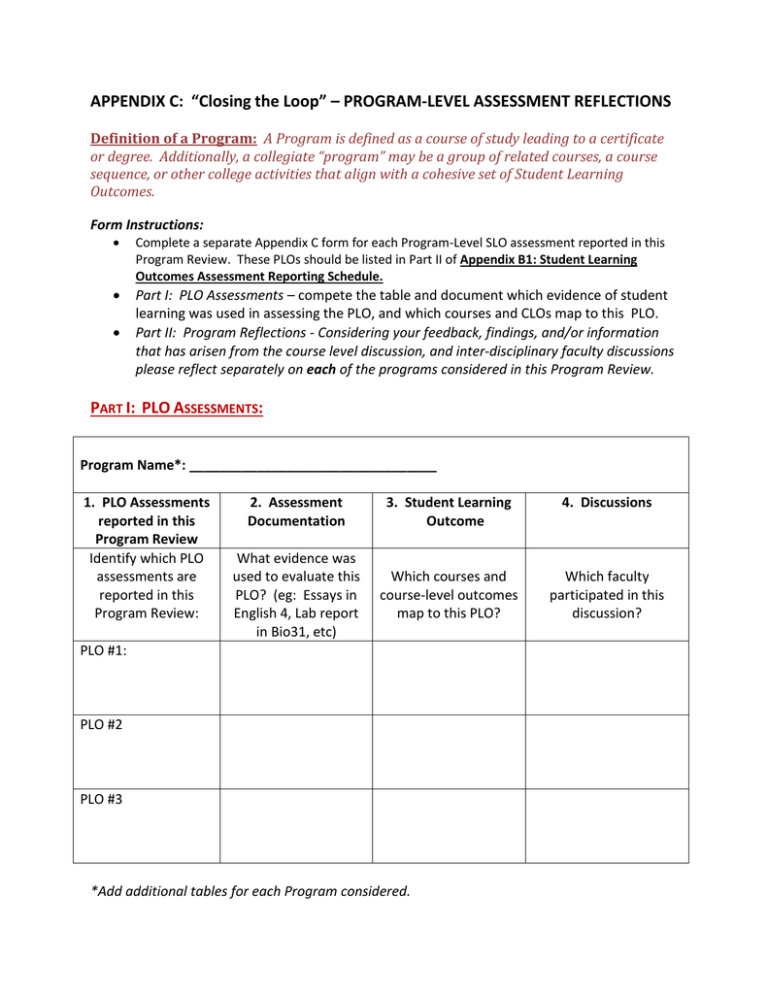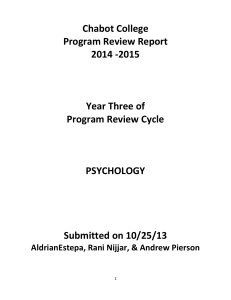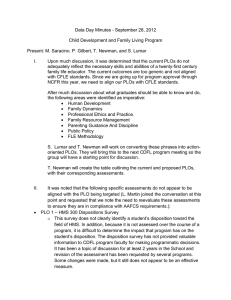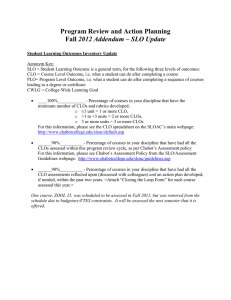APPENDIX C: “Closing the Loop” – PROGRAM-LEVEL ASSESSMENT REFLECTIONS
advertisement

APPENDIX C: “Closing the Loop” – PROGRAM-LEVEL ASSESSMENT REFLECTIONS Definition of a Program: A Program is defined as a course of study leading to a certificate or degree. Additionally, a collegiate “program” may be a group of related courses, a course sequence, or other college activities that align with a cohesive set of Student Learning Outcomes. Form Instructions: Complete a separate Appendix C form for each Program-Level SLO assessment reported in this Program Review. These PLOs should be listed in Part II of Appendix B1: Student Learning Outcomes Assessment Reporting Schedule. Part I: PLO Assessments – compete the table and document which evidence of student learning was used in assessing the PLO, and which courses and CLOs map to this PLO. Part II: Program Reflections - Considering your feedback, findings, and/or information that has arisen from the course level discussion, and inter-disciplinary faculty discussions please reflect separately on each of the programs considered in this Program Review. PART I: PLO ASSESSMENTS: Program Name*: _________________________________ 1. PLO Assessments reported in this Program Review Identify which PLO assessments are reported in this Program Review: 2. Assessment Documentation 3. Student Learning Outcome 4. Discussions What evidence was used to evaluate this PLO? (eg: Essays in English 4, Lab report in Bio31, etc) Which courses and course-level outcomes map to this PLO? Which faculty participated in this discussion? PLO #1: PLO #2 PLO #3 *Add additional tables for each Program considered. PART II: PROGRAM REFLECTIONS: 1. What program-level strengths have the assessment reflections revealed? 2. What are the most critical student learning issues impacting the success of students in your program? Such issues could include: student understanding of key program concepts, skills that are essential to success following program completion, abilities that students struggle to master, skills needed for subsequent courses in a pre-requisite sequence, etc. 3. Which of these would you like to focus on at a program level this cycle? (You can choose more than one). What program or course Student Learning Outcomes are related to the selected issue(s)? 4. What might be done to facilitate student success in this area? Include effective strategies currently being utilized in department in this discussion. 5. How might you assess the effectiveness of these strategies? Please mark all that apply Direct observation of student actions or performance (e.g. student skills during theatre performances or athletic events, structured practice or drills, student work in laboratory or studio classes, results of “practical” exams, etc.) Analysis of student creative work (e.g. art portfolios, creative projects in classes, student projects as part of a campus cultural event, etc.) Assessment of student products (e.g. review of semester projects, grades on inquiry projects, etc.) Exams, quizzes, and/or problem sets in courses (items linked to specific outcomes) Grading of assignments based on rubrics (essays, reports, case studies, etc.) Analysis of student work on problem sets, homework, etc. Student self-assessments (reflective journals, surveys, etc.) Capstone projects or final summative assessment (e.g. final exams, capstone projects, etc.) Guided discussion (group or individual) Other (please describe):


